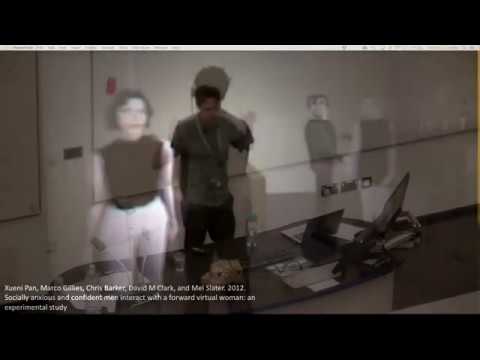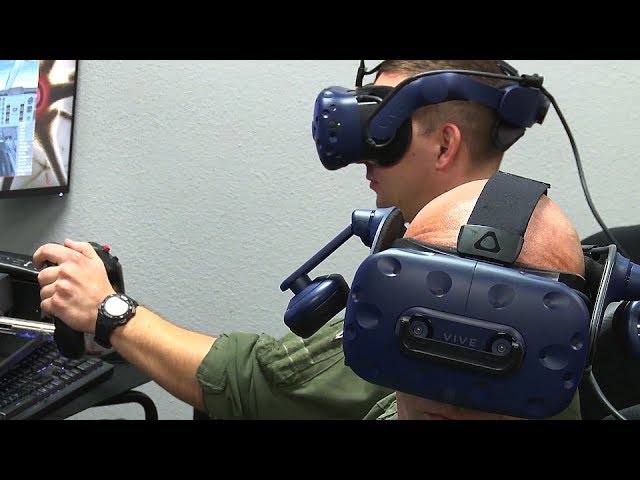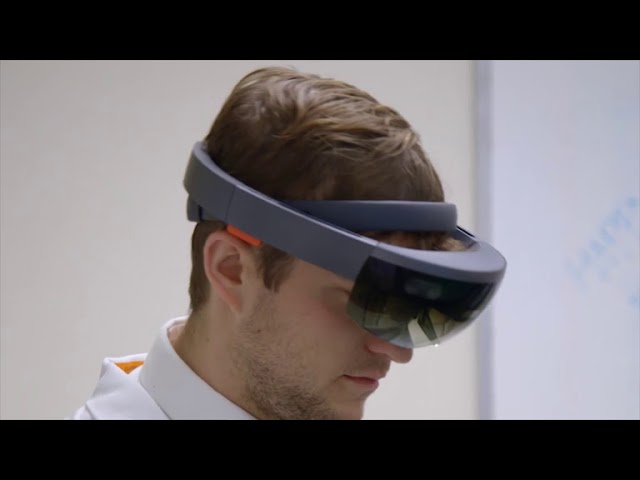Do you like to play VR games? How about testing them? VR and Augmented Reality were one of the main subjects at the 2019 edition of Mobile World Congress in Barcelona. With new advances in the industry, testers need to bring their creativity to the table. At Altom, we are keen on using automation whenever we find mechanical, repetitive actions. The TurnTable is a tool that simulates various movements (like head movements) so that we can run automated tests on apps for panoramic photos or on some more complex projects, like VR applications and games. Find out more https://altom.com/testing-tools/turntable/
Video category: Virtual reality use cases
Virtual reality training immerses employees in dangerous scenarios
Virtual reality is often associated with video games. But well-known companies are now using it as a tool to train for potentially dangerous situations. Companies like Walmart, Chipotle, and Verizon are using VR to prepare employees for what they could see on the job. Tony Dokoupil reports. Watch "CBS This Morning" HERE: http://bit.ly/1T88yAR Download the CBS News app on iOS HERE: https://apple.co/1tRNnUy Download the CBS News app on Android HERE: https://bit.ly/1IcphuX Like "CBS This Morning" on Facebook HERE: http://on.fb.me/1LhtdvI Follow "CBS This Morning" on Twitter HERE: http://bit.ly/1Xj5W3p Follow "CBS This Morning" on Instagram HERE: http://bit.ly/1Q7NGnY Get new episodes of shows you love across devices the next day, stream local news live, and watch full seasons of CBS fan favorites anytime, anywhere with CBS All Access. Try it free! http://bit.ly/1OQA29B Delivered by Norah O’Donnell, Gayle King, John Dickerson, and Bianna Golodryga, "CBS This Morning" offers a thoughtful, substantive and insightful source of news and information to a daily audience of 3 million viewers. The Emmy Award-winning broadcast presents a mix of daily news, coverage of developing stories of national and global significance, and interviews with leading figures in politics, business and entertainment. Check local listings for "CBS This Morning" broadcast times.
The power of Virtual Reality in Education
Awarded University of the Year for Teaching Quality (Good University Guide, The Times & Sunday Times 2019), Aberystwyth is rated Gold in the Teaching Excellence and Student Outcomes Framework (TEF 2018) and is one of the best Universities in the UK for student satisfaction with a score of 90% in the UK (NSS 2018). For more information, visit: http://www.aber.ac.uk Follow us on: Facebook: https://www.facebook.com/AberystwythU... Twitter: https://twitter.com/AberUni\
VR4HE – Virtual Reality for Learning Social Skills – Dr Marco Gillies
Dr Marco Gillies Academic Director: Online Learning, Goldsmiths, University of London Biography: Marco Gillies has over 20 years’ experience of research in Virtual Reality and Virtual Humans. His particular focus is on social interaction. He is also Academic Director: Online Learning in the Teaching and Learning Innovation Centre. As part of that role he is responsible for innovation in the use of technology for learning. Combining those roles he has a strong interest in the use of VR for education, and in particular using VR for training for social interaction. The work presented is in collaboration with Sylvia (Xueni) Pan, Lecturer in Computing at Goldsmiths. Title: Virtual Reality for Learning Social Skills Category: Qualitative change in learning Abstract: Many professions combine the need for technical or academic knowledge with a need to interact with people. Good social skills are a very important factor and professional social skills may differ from day to day social interaction skills (for example, professional communication, negotiation, breaking bad news). A good example is medical professionals: the scientific knowledge and diagnostic skills required are among the most intellectually challenging of all professions, but doctors and nurses must also interact with patients in some of the most stressful situations of their lives. Academic knowledge is well covered by a traditional education, but learning social skills is often left to more informal situations. They can only be learned through real practice, but opportunities are rare: either with real patients which is high risk, or with actors, which is high cost. Virtual Reality opens up an opportunity to practice social interactions freely in a safe, low risk environment. The scenarios can be tightly controlled to ensure a consistent experience between students and that appropriate learning outcomes are met. Virtual reality is particularly appropriate for this type of learning because it supports realistic body language: users share a virtual space where thing like eye-contact and gesture work as in the real work, unlike screen based interaction. This talk will give an overview of 2 decades of work on social interaction in VR with a particular focus on social skills learning. It will describe practical applications in medical and other domains and describe the major technical and learning challenges involve.
Interesting—USAF utilizes VIRTUAL and AUGMENTED REALITY in latest PILOT INSTRUCTOR TRAINING.
Interesting—USAF utilizes VIRTUAL and AUGMENTED REALITY in latest PILOT INSTRUCTOR TRAINING. Official release: At Joint Base San Antonio-Randolph, pilot instructor trainees assigned to the 12th Flying Training Wing, are utilizing a variety of emerging technologies to aid in their learning and development. It’s known as Pilot Instructor Training Next, also referred to as PIT Next, a technology-based learning approach, which began with Pilot Training Next, an undergraduate pilot training program that leverages virtual and augmented reality. Credit: Sean Schroeder, United Staes Air Force.
Christiana Care Virtual Reality at the Helen F. Graham Cancer Center & Research Institute
In the spirit of serving together, the team at Christiana Care's Helen F. Graham Cancer Center & Research Institute team partnered with the Innovation Center to bring virtual reality to patients for a more relaxing chemotherapy experience. This pioneering approach earned Christiana Care 2018 American Nurses Credentialing Center Magnet Prize at the National Magnet Conference.
6. Virtual and Mixed Reality for Medical Education
Virtual and mixed reality involve the use of computer technology to create simulated and hybrid environments. Popular for their gaming applications, virtual and mixed reality, with their futuristic affect, never fail to dazzle audiences. But VR/MR technology is much more than a game. Virtual and mixed reality systems have recently caught the eye of healthcare professionals eager to sharpen their skills. Now popular for medical education, VR/MR programs provide simulation training that serves to enhance traditional medical schooling. Education via simulation is a productive step toward the system’s most adept and confident healthcare providers.
VReate – “Virtual Reality engineered assembly training for education” (VR Montagetraining)
As part of my bachelor thesis I developed a virtual assembly training with the help of the Unreal Engine 4, which is mainly suitable for teaching purposes in training and further education, but also for assembly and shoring investigations and serves the visualization of technical components. The aim of the application is to learn various working steps up to the replacement of the two overhead camshafts (DOHC) of a four-cylinder engine. The instruction of the working steps is carried out with the help of a small "Head-Up-Display", which is positioned at the wrist of the user. To simplify the work steps, a universal tool for carrying out the assembly simulation was integrated. The entire project is based on the Blueprints Visual Scripting System of the Unreal Engine 4. The models used come from the exchange platform grabcad.com and are therefore subject to its legal regulations regarding private and commercial use. Im Rahmen meiner Bachelorarbeit habe ich mithilfe der Unreal Engine 4 ein virtuelles Montagetraining entwickelt, welches hauptsächlich für Lehrzwecke in der Aus- und Weiterbildung, aber auch für Montage- und Verbauuntersuchungen geeignet ist und der Visualisierung technischer Komponenten dient. Ziel der Anwendung ist das Erlernen diverser Arbeitsschritte bis hin zum Austausch der beiden oben liegenden Nockenwellen (DOHC) eines Vierzylindermotors. Die Anleitung der Arbeitsschritte erfolgt mithilfe eines kleinen "Head-Up-Displays", welches am Handgelenk des Anwenders positioniert wurde. Zur Vereinfachung der Arbeitsschritte wurde ein universelles Werkzeug zur Durchführung der Montagesimulation integriert. Das gesamte Projekt basiert auf dem Blueprints Visual Scripting System der Unreal Engine 4. Die verwendeten Modelle stammen von der Austauschplattform grabcad.com und unterliegen somit deren rechtlichen Bestimmungen hinsichtlich des privaten und kommerziellen Gebrauchs.
Incorporating virtual reality in the classroom | Mfon Akpan | TEDxTrestleViewPark
Why should we care about virtual reality in the educational environment? Mfon Akpan is passionate about the opportunities virtual reality can give our students today. In his energizing talk, he answers why we should care about virtual reality in the classroom. Mfon Akpan is an accounting professor and enthusiast for virtual reality in education. Mfon is a full-time faculty member in the Harrison Professional Pathways Program at National Louis University. He holds a bachelor’s degree from the Illinois Institute of Technology, a MBA and Masters in Accounting and Financial Management from Keller Graduate School of Management and is currently a doctoral candidate, majoring in accounting, at Argosy University. Mfon is also adjunct accounting faculty at Robert Morris University, adjunct business faculty at Olive-Harvey and Harold Washington College. Prior to his doctoral work, he had a successful career as a banker for JPMorgan Chase. Mfon loves teaching and engaging with his students on and off line. He enjoys incorporating innovative methods of teaching including using social media, his YouTube channel and other emerging technologies. Mfon is an active member of the American Accounting Association’s Conference on Teaching and Learning in Accounting. This talk was given at a TEDx event using the TED conference format but independently organized by a local community. Learn more at https://www.ted.com/tedx
JunoVR: Improving a Breath Sensor for Virtual Reality (VR) Applications
Full Title: JunoVR: Improving a Breath Sensor for Virtual Reality (VR) Applications Presenters: Thomas Driver, Brandon Perry Advised by: Morgan Benton Sponsors: Chris Smith -- JunoVR Abstract: In today’s world technology is advancing faster each year and is able to aid us in finding solutions in critical areas of our lives. One of these critical areas is health-care facilities. The doctors and staff working within these facilities are in an environment where they often need to know at a moments notice the location of a patient or other health specialist. One solution to this need is the LoCATE system which uses the improvements in technology to track people in near real time. LoCATE makes use of the current 802.11 wireless networks within a health-care facility and edge node technology as its tracking solution. The edge nodes constantly communicate with the current network in an non-intrusive manner. The data collected from the network with the edge nodes is able to locate the carrier of the edge node within a reasonable range of variability. The data is then pushed and stored on a cloud storage system where it waits to be accessed by our mobile application. The mobile application will display the near real time location of any patient or staff member. The small size of the edge nodes allows for anyone to easily carry the node on a lanyard around their neck. This simple and small solution known as LoCATE is cost effective due to the use of the current 802.11 wireless network infrastructure. Overall LoCATE is the solution that the health-care facilities need and in a short time will be tested and implemented. Virtual Reality (VR), a rapidly growing technology, provides a fully immersive visual and auditory experience. While VR’s early applications were predominantly games and entertainment, recent applications have expanded to education and therapy. VR has been used to treat PTSD, chronic anxiety, provide portable “sensory rooms” for people with autism spectrum characteristics, and to help people learn to meditate and cultivate mindfulness. JunoVR, the sponsor of this project, developed a novel input/output device, a breath sensor, that allows VR users to visualize and control their breath while meditating. The goal of this project was to take the JunoVR breath sensor prototype and develop the design to make it more durable, easy to manufacture and assemble, and affordable to produce. The team also explored making the product wireless and able to support multiple different VR platforms.














